Services on Demand
Journal
Article
Indicators
-
 Cited by SciELO
Cited by SciELO -
 Access statistics
Access statistics
Related links
-
 Cited by Google
Cited by Google -
 Similars in
SciELO
Similars in
SciELO -
 Similars in Google
Similars in Google
Share
CT&F - Ciencia, Tecnología y Futuro
Print version ISSN 0122-5383On-line version ISSN 2382-4581
C.T.F Cienc. Tecnol. Futuro vol.3 no.4 Bucaramanga Jan./Dec. 2008
1 Universidad Industrial de Santander (UIS), Ingeniería Química, Bucaramanga, Santander, Colombia
2 Ecopetrol S. A - Instituto Colombiano del Petróleo, A.A. 4185, Bucaramanga, Santander, Colombia
e-mail: hector.picon@ecopetrol.com.co e-mail: acenteno@uis.edu.co
(Received April 25, 2008; Accepted Oct. 22, 2008)
* To whom correspondence may be addressed
ABSTRACT
Amorphological classification of cokes from the Castilla and Jazmín Colombian crude oils was completed. These heavy-nature crude oils, after being fractioned during the refining stages, were physicochemically characterized and submitted to the coking process. The conclusions of this work are based on the characterization of the feedstock chemical composition according to the type of aromatic carbon. UV visible spectrophotometry and the corresponding micrographs obtained by a Scan Electron Microscope (SEM), in amplification intervals from 100X to 5000X for the samples of formed cokes, were analyzed. Results of this work allowed the determination of the morphological classification intervals in function of the polyaromatic compound concentration ratio (tetraromatic / triaromatic, and diaromatic / triaromatic) of the different coked feedstocks. Furthermore, high content of calcium and sulfur in the feedstocks promotes morphologies of the associated - shot type.
Key words: coke, characterization, Castilla crude, Jazmín crude, spectrometry, scanning electron microscopy, heavy oils.
RESUMEN
Se realizó una clasificación morfológica de los coques obtenidos a partir de los crudos colombianos Castilla y Jazmín. Estos crudos de naturaleza pesada, luego de ser fraccionados en las diferentes etapas de refinación, fueron caracterizados fisicoquímicamente y sometidos al proceso de coquización. Las conclusiones de este trabajo se basan en los resultados de la caracterización de la composición química de la carga por tipo de carbono aromático, empleando espectrofotometría ultravioleta visible y las correspondientes micrografías adquiridas con un Microscopio Electrónico de Barrido (SEM); en un intervalo de ampliación de 100X a 5000X para las muestras de los coques formados. Los resultados de este trabajo permitieron establecer los intervalos de clasificación morfológica, en función de la relación de concentración de poliaromáticos (tetra aromático a tri aromático y di aromático a tri aromático) de las diferentes cargas coquizadas. Además, se pudo determinar que los altos contenidos de calcio y azufre en las cargas promueven morfologías tipo perdigón asociado.
Palabras Clave: coke, caracterización, crudo Castilla, crudo Jazmín, espectrometría, microscopía electrónica de barrido, crudos pesados.
INTRODUCTION
Rational utilization of raw materials, i.g., heavy and extra-heavy crude oils and bituminous materials, is presented as an alternative for the improvement of refining margins and energy efficiency. Recently, large companies and research institutes have directed all their efforts toward the analysis and classification of the different morphological formations of the cokes obtained during the coking process. Heavy crude oils are characterized by a low hydrogen/carbon ratio, high content of heteroatoms such as sulfur, nitrogen, nickel, vanadium and low yield of light hydrocarbons. Upon submitted to distillation processes, only 50% of the crude oil can be recovered by vacuum distillation (Gray, M. R., 2003). Therefore, the utilization of high-conversion processes is necessary in order to transform heavy and extra-heavy fractions in valuable hydrocarbons.
The coking process offers a solution for the heavy and extra-heavy oil treatment as well as for the bituminous material. High percentages of coke formed during the coking process, encourage and orientate the application of new research and developments in order to increase its value and use in both the energy and chemical market. A morphological classification of the coke formed from two Colombian heavy-natured crude oils is conducted in this work: Castilla crude oil and Jazmín crude oil. These crude oils were processed in different refining stages, obtaining fractions with high boiling points that were physicochemically characterized. Then, they were submitted to the coking process to get the corresponding coke samples. Cokes obtained were classified morphologically in shot coke type, associated shot coke and sponge coke with a SEM.
Chemical composition analyses, according to the type of aromatic carbon of the coked fractions, were conducted using UV visible spectrophotometry. Results of the spectra were correlated by SHELL methodologies, thus ensuring better analysis reliability. Results of the chemical composition of the coked feedstocks together with the corresponding SEM micrographs of the cokes so - formed, provided clues toward the identification of morphological classification intervals based on the polyaromatic concentration (tetra aromatic / tri aromatic and diaromatic / triaromatic) in the coked feedstocks.
Therefore, the chemical composition according to the type of polyaromatic carbon in coked feedstocks, together with the quantification of metallic heteroatoms, such as Nickel, Vanadium and Calcium (as recently reported), allowed morphology prediction in formed cokes within the collector drum. This conclusion broadens the metallic interval that, in general terms, is restricted to the Nickel / Vanadium couple, commonly used in morphology orientation and prediction in the cokes obtained during the coking reactions (Siskin et al., 2006; Kelemen et al., 2007).
THEORETICAL FRAMEWORK
At industrial level, the morphological classification of the coke formed in the coking drum is described according to its macroscopic appearance (sponge coke, shot coke, etc). Sponge coke, as suggested by its name, exhibits a sponge-like appearance with different pore and bubble sizes trapped in a coke solid matrix. The shot-type coke is characterized by the presence of small spheres whose average diameter ranges between 1mm and 4 mm. The transition-type coke is described as a coke where morphological characteristics from the sponge-like coke predominate with discrete formation of spheroid particles of the shot-type coke (Siskin et al., 2006). The transition-type coke increases the operation risk during the decoking process and extends the maintenance and suitability time of the coke collecting drum. Therefore, the study of mechanisms in transition-type coke formation requires special attention and analysis since controlling this morphology and avoiding its presence in the coke collecting drum is a complex issue.
The maximization schemes of distilled materials yield show that, in general terms, there is no morphological uniformity within the coke-collecting drum. The shot-type morphology predominates at the drum bottom, followed by a transition morphology characterized by loosen and associated pellets in a spongy matrix, finishing with a sponge-like morphology at the drum top. Therefore, production of shot-type coke is preferred in coking schemes oriented toward the maximization of distilled material due to the fact that this material can be easily removed from the coking drum. This fact results in an increment of the effective capacity of the process (Siskin et al., 2006). However, when a research is conducted on coke morphological modification and classification, microscopic studies must be included regarding the evolution and formation of mesogenic regions since coking reactions affect and modify the anisotropic microstructure in the formed coke.
Thermal decomposition reactions increase the molecular aggression in high boiling point fractions, extending to the mesogenic regions, thus promoting fluidity and generation of volatile materials. These compounds reach a maximum value thus inducing the formation of a dilated viscous material. Temperature increments around 500°C (773,15 K) in this viscous material promote condensation reactions which start to dominate, decreasing the availability of transferable hydrogen in the stabilization of free radicals. This fact is reflected in the decrease of fluidity of the viscous mass, which eventually solidifies. Finally, additional heating causes secondary gasification, characterized mainly by hydrogen loss that, in turn, leads to the contraction of solidified mass, which results in coke formation. (Gray & Marsh H., 1989; Loison & Marsh A., 1989).
The mesophase complex reology (crystal-type fluid) controls coalescence that, in turn, depends on the chemical composition of the asphaltenic material and its capability of transferring hydrogen to the active radicals that contribute to the maintenance of low viscosity in the mesophase, thus leading to the formation of a better quality coke. Therefore, knowing the transformation of these materials at the mesogenic region is of the essence. This transformation is an important factor to be considered in the formation of the different coke morphologies (Murray, Elliot, & McCaffrey, 2005).
Coke morphology is affected by complex, interrelated factors that include the quality of the coked feedstock. Recent research conducted by Zander and Collin (1993), in the polyaromatic chemistry area, confirms these facts. Preliminary studies have found that metal content in the feedstock, such as Nickel and Vanadium, is an important parameter to be considered in the modification of coke morphology (Siskin, Kelemen, Eppig, Brown, & Afeworki, 2006). In addition, operational conditions and coke collector hydrodynamics interfere in coke morphology. Therefore, determination of morphology, its texture and porosity are important indicators of the quality of the cokes formed during the coking process. A morphological classification of the coke type can be completed microscopically by using the Polarized Light Microscope and the SEM.
Measurement of optical properties using the polarized light microscope can reveal many problems caused mainly by the treatment applied to the coke sample. Therefore, the sample can be deformed easily during cleaning, polishing and shining processes thus destroying the characteristics to be examined. In this case, it is preferable to conduct measurements using non-destructive techniques in the coke formation pattern, its porous structure and distribution, and its shape and distribution within the reactor (Karacan & Badger, 2003).
Contrasts found in morphologies and texture of formed cokes can be attributed to the difference in molecular composition of processed feedstocks in the pilot coking plant. Even though carbonization chemistry is complex, the characteristics related to the reactivity in the coking process are basically inferred to be due to the degree of alkylic substitution in the aromatic ring system and its poly aromatic configuration (Figure 1), thus generating different coke types depending on the above mentioned factors.
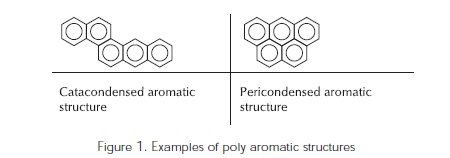
Figure 1 illustrates examples of poly aromatic structures (catacondensed and pericondensed). The literature reports at least two types of formation mechanisms for poly aromatic structures. The first one is called sequential growth mechanism and the second one is a condensation mechanism.
The sequential growth mechanism involves the alkylation of aromatic condensed molecules by free radicals followed by a cycling and dehydrogenation process which, in turn, produces elongated condensed poly aromatic molecules (catacondensed).
In the liquid phase, coking of alkyl Polyaromatic Hydrocarbons (alkyl PAHs) is completed by a complex mechanism of free radicals. The initiation stage involves the formation of free radicals via homolysis of the C-H bonds or by the abstraction of hydrogen in the metyl groups of polyaromartic compounds, thus resulting in the formation of benzilic radicals that can alkylate the aromatic free radicals in the rest polyaromatic compounds, forming intermediate molecules of the Di-aril methane type. Free rotation of methane axis in the diaril - methane radical induces the formation of molecules composed by 5 or 6 rings (Wang, 2005).
Figure 2 illustrates the condensation mechanism where large polyaromatic structures are formed from small pericondensed structures (Sullivan, Boduszynski, & Fetzer, 1989). The route indicated by the black arrows describes the mechanism by which the available "bay regions" are occupied by cyclic structures. The white arrows indicate the ring adding mechanism over the poly aromatic molecule.
A= naphtalene,
B= phenantrene,
C= pyrene,
D= benzo(e)pyrene;
E=benzo(ghi)perilene,
F=coronene,
G=dibenzo(e,ghi)perilene,
H=benzo(pqr)naphto(8,1,2bcd)perilene,
I=naphto(8,2,1abc)coronene,
J=ovalene
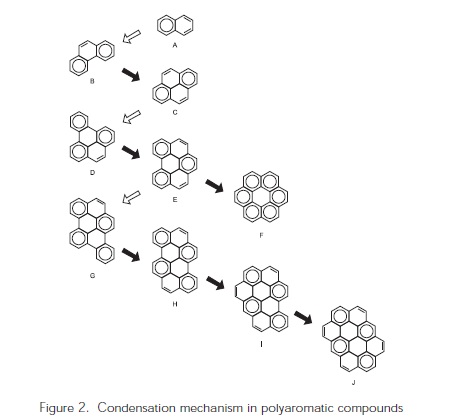
Keller, Kovacs and Homann (2000), provide an explanation for the stability of polyaromatic pericondensed compounds (coronene and ovalene) based on the polyaromatic condensation mechanisms and postulate that the tricarbonated bay regions are less reactive than the tetrahedral or pentagonal ones (Figure 3). Therefore, since coronene and ovalene have tricarbonated bay regions only, they are less reactive than polyaromatic compounds with similar Hydrogen / Carbon ratios.
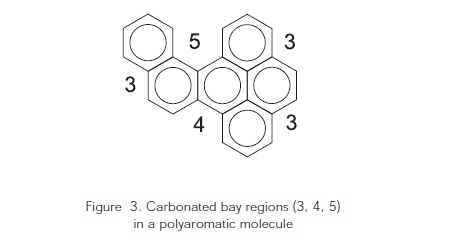
Recent research on the characterization of the chemical composition of hydrocarbonated fractions with high boiling points have used mass spetrometry and magnetic nuclear resonance {Carbon (13C) and Hydrogen (1H)} and spectrophotometry with very good results (Wentzell, Andrews, Wall, Cooley, & Spencer, 1999; Baldrich & Novoa, 2007). The chemical composition of the coked feedstocks used in this work were found by using UV visible spectrophotometric techniques, using the SHELL SMS-2783-95 methodology, for the identification of the chemical composition according to the type of carbon (mono-aromatic, di-aromatic, tri-aromatic, tetra-aromatic, penta-aromatic, etc.).
The presence of isomers in the petroleum heavy fractions, as well as restrictions on the separation of all possible components in the chromatographic column have provided orientation for the expression of the chemical composition of heavy fractions according to the compound type and not as individual components (Bouquet & Brument, 1990; Badger, Mitchel, & Karacan, 2001; Baldrich & Novoa, 2007). One of the best methods to define the chemical composition of petroleum middle and heavy fractions according to the type of hydrocarbon contained in the feedstock , is the high resolution mass spectrometry-based analysis. High resolution allows the analysis without previous sample separation. (Bouquet & Brument, 1990), thus ensuring greater analysis reliability.
This article presents the correlation between the chemical composition of coked feedstocks according to the polyaromatic family and the type of morphology formed by the cokes obtained. The morphologic classifi cation intervals based on polyaromatic concentration were found (from tetra aromatic to tri aromatic and from di aromatic to tri aromatic) in the coked feedstocks. The poly aromatic morphologic classification intervals together with the quantification of metallic heteroatoms, such as nickel, vanadium and calcium allowed to forecast the morphology of the coked formed.
EXPERIMENTAL DEVELOPMENT
Materials
Castilla and Jazmín crude oils {Included in the PetroTech Intel international list PTI-CIMS (3000 crude oils)} were processed in the different refining stages to obtain fractions with high boiling points. The following products were obtained from the Castilla crude oil: reduced crude oil, asphaltenic bottom of reduced crude oil and asphaltenic bottom from the vacuum bottom. The Jazmín crude oil was fractioned in reduced crude oil and vacuum bottoms. The refined fractions were characterized from the physicochemical standpoint at the Ecopetrol S.A.- Instituto Colombiano del Petróleo (ICP) laboratories according to the methods set out by the American Society of Tests and Materials (ASTM) available for each case. Then, these samples were submitted to the coking process at the pilot plant, producing coke samples per each distilled fraction.
The SARA analysis conducted up to an alternative method for hydrocarbon fractionation that collects and consolidates procedures of the Standard ASTM D2007- 03, D2549-07 and Standard IP-143-96.
Samples with content greater than 0,1% wt of asphaltenes (% insolubles n-heptane) should be separated from the sample prior to analysis of Maltenes by Chromatographic techniques. To that end, it makes a Soxhlet extraction with n-heptane to solubilise the Maltenes, leaving precipitated the asphaltenes and any type of inorganic materials and / or non-soluble organic solvent. Subsequently, the asphaltenes are extracted with Toluene. Finally the maltenes are separated by column chromatography. Obtaining, these fractions of oil-rich, Saturates, Aromatics and Resins (SAR).
UV Visible Spectrophotometer (UV - VIS)
The chemical composition analyses according to the type of aromatic carbon in coked feedstocks were conducted at the laboratories of the ICP using a Hewllett Packard UV visible spectrophotometer, model (HP- 8453). The detailed composition results of fraction per hydrocarbon type from the UV visible spectrum were calculated using the SHELL (SMS -2783-95) methodology.
Pilot Plant
The coking pilot plant has been designed and built using technology provided by the ICP - Ecopetrol S.A. It consists of the following sections:
Feedstock Section: The feedstock (vacuum bottom, asphaltenic bottoms and/or heavy crude oils) is preheated and maintained at the temperature of 60°C - 180°C (333,15K - 453,15K), by a resistance-type electrical heating system. A scale supports the drum feeding the reactor in order to quantify the amount of feedstock processed in the run.
Reaction Section: The preheated feedstock in the feedstock section is fed with a piston-type pump toward the oven-reactor battery. The flow managed by the unit is at an interval of 0 g/min - 85 g/min. The oven structure is a monel cylinder with 0,1m diameter and 0,4 m height, heated by 220 volt electrical resistance, which are covered by a thermal insulation material, protected by a stainless steel case. Stainless steel 316 with low nickel content is used for the construction of the reactor, which is basically a cylinder whose inner diameter measures 0,085m and 0,4m long. The reactor is fed from the lower part. The temperature of the oven-reactor battery is monitored with type K thermocouples located in the upper, middle and lower part of this structure.
Product Recovery Section: The reactor efflux is sent to a separator manufactured in stainless steel 316. A light current (naphthas and gases) is separated from the products coming form the reactor by instant vaporization in the separator. This passes to a condenser and in a heavy current (gas oil type distillates) that accumulates within the separator until the end of the run term. The naphtha coming from the condenser is collected at the drum bottom that is also made of stainless steel. The gases escaping at the top are quantified in a gas meter and then they are taken to a neutralization tank with soda in order to neutralize the high sulfhydric acid content.
The coking pilot plant (Picón et al., 2001) allowed the simulation of relevant operating conditions in the coking process and the obtaining of the corresponding coking samples. Cokes formed showed well-defined morphologies depending on the type of feedstock submitted to the coking reactions.
Scan Electron Microscope
The microscopic analysis was conducted with a FEI Quanta 200 environmental scan electron microscope. External and internal coke surfaces, previously covered with gold in fresh fracture surfaces, were examined. Images observed included the micrographs shown in this document. These were obtained using an Electron Transfer Dissociation Device (ETD). Images in the interval from 100X through 5000X were obtained for the different cokes from processed currents at the coking pilot plant, finding information about the morphology of the coke obtained. Some microscope operation parameters are described at the bottom of the micrographs as well as a scale line in order to estimate the size of the zones of interest (mm stands for millimeter, and µm stands for micrometer).
RESULT ANALYSIS
Table 1 shows the SARA analysis of Castilla and Jazmín heavy crude oils, represented in the weight percentage of saturates, aromatics, resins, and asphaltenes. Heavy crude oils were characterized by the presence of considerable amounts of asphaltenes which, in turn, play an important role in the increase of viscosity of coked feedstocks.
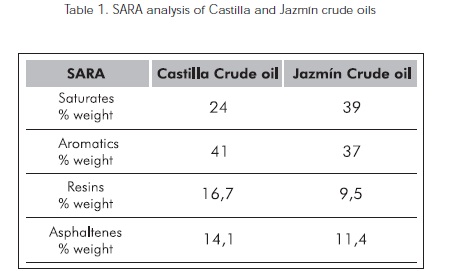
Table 2 shows the minimum physicochemical characterization required for the morphological classification of fractions from the Castilla crude oil. Fractions are characterized base on their high asphaltene, sulfur, nickel, and vanadium content. Low calcium content, however, is evidenced.
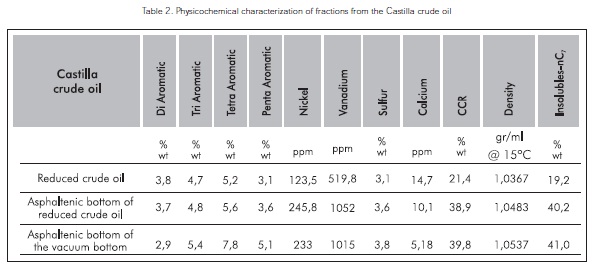
Table 3 shows the physicochemical characterization of coked feedstocks from the Jazmín crude oil. Feedstocks were characterized by their moderate nickel, vanadium y asphaltene concentrations, quantified as the weight fraction of the insoluble in normal Heptane (insoluble-nC7). High calcium concentrations in the Jazmín crude oil fractions is highlighted.
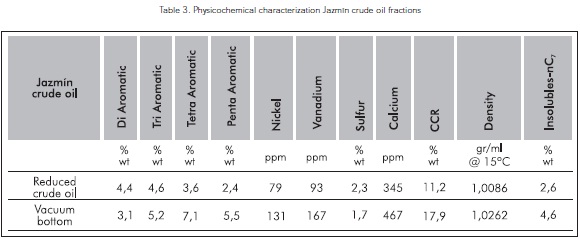
Figure 4 shows the carbon - type based tetra-aromatic / tri-aromatic ratio vs. the percentage weight of carbon micro in coked feedstocks. The percentage in weight of carbon residues is a feedstock quality indicator since it provides information regarding the coke formation potential in coked feedstocks (Siskin et al., 2006). The increment of the tetra-aromatic / tri-aromatic ratio present in coked feedstocks as well as the penta-aromatic concentration provide a possible explanation about the morphological formation of shot-type and associated shot cokes. This analysis is confirmed with the decrease of the di-aromatic / tri-aromatic ratio in coked feedstocks (Figure 6), according to the condensation mechanisms proposed for poly-aromatic compounds. (Sullivan et al., 1989; Zander & Collin, 1993).
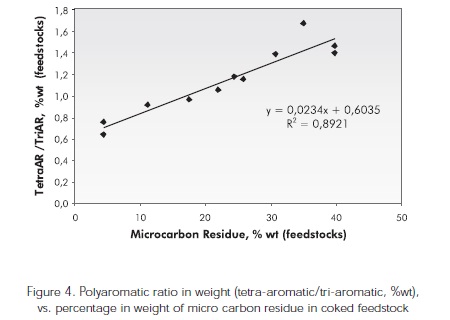
Figure 5 shows how an increment in the percentage of micro carbon residue in coked feedstocks results a concentration increment of poly-aromatic pentagonal structures as determined by spectrophotometry (UVVIS) which, upon submission to the coking process, promote larger polyaromatic pericondensed structure, according to the condensation mechanisms described by Sullivan et al., (1989) and Wang (2005).
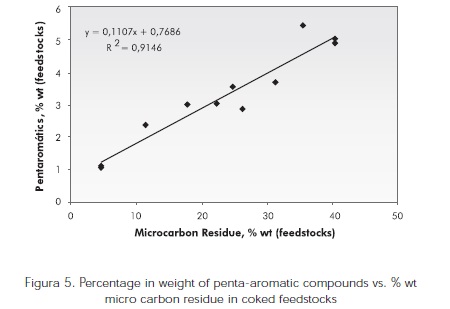
Figure 6 shows the di-aromatic / tri-aromatic ratio of coked feedstocks. A decrease in di-aromatic concentration is observed upon the increase of the micro carbon residue in coked feedstocks. This decrease provides a possible explanation for the formation of shot-type and shot associated structures, confirmed by the scan electronic micrographs (Figure 7).
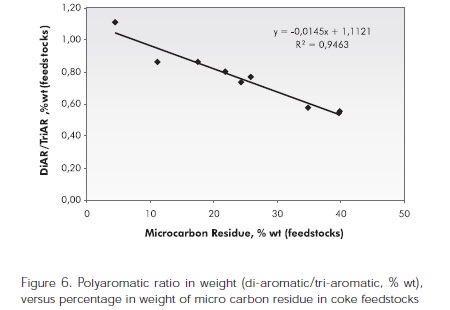
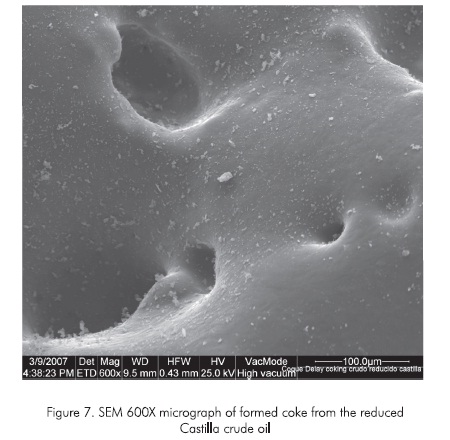
Therefore, highly isotropic and amorphous textures in the coke can be associated to high tetra-aromatic and tri-aromatic concentration ratios in coked feedstocks since they are promoters of poly aromatic structure with a greater number of benzene rings. Furthermore, this concentration ratio can also be associated to the gradual formation of large amorphous structures with enough time in the coked fluid, characteristic of the shot-type and shot associated cokes.
A morphological classification obtained for two heavy crude oils is presented below as well as the analysis conducted for the coke formed with processed currents in the coking pilot plant. The conclusions are correlated to the chemical composition results by the characterization of aromatic carbon-type feedstocks (UV-VIS spectrophotometry), and to the corresponding scan electronic micrographs at magnification internals from 100X through 5000X for the different samples analyzed.
CASTILLA CRUDE OIL
Shot-type cokes
Cokes formed from high boiling point fractions of the Castilla crude oil were classified from the morphological standpoint in shot-type cokes, which exhibited a spheroid shape characterized by presenting very smooth surfaces, with holes and pores.
Figures 7 and 8 show the SEM micrographs at application intervals of 600X and 2000X, respectively for the coke obtained from the Castilla crude oil. This crude oil is characterized by its high content of penta-aromatic structures (3,1% wt), with tetra-aromatic / tri- aromatic concentration ratios greater than 1,1% weight with values greater than 600 ppm (Table 2) regarding the sum of the metal contents (nickel and vanadium). Therefore, comparing the coke sample obtained by Ali (2002) to the formed coke and considering the feedstock chemical composition, the shot-type coke characteristics are evident for the coke formed. Recently, similar results have been reporters by researchers in this topic where high nickel, vanadium, and asphaltene content lead to the shot-type and shot-associated morphologic formations (Siskin et al., 2006; Kelemen et al., 2007; Elliot, 2000).
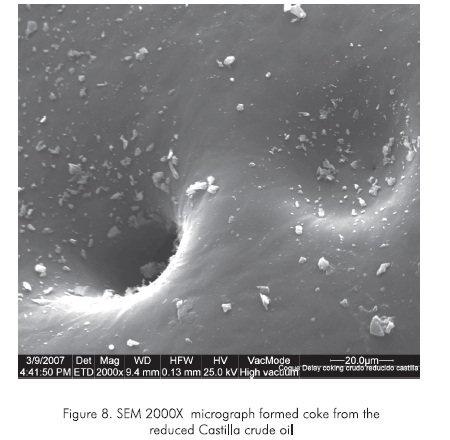
Figure 9 shows the micrograph obtained at 5000X magnification for the coked sample formed from the Castilla reduced crude oil. The very smooth surface of the pore and hole formed clearly observed with a particulate content. In terms of chemical composition, this morphology and texture is present in coked feedstocks with high content in asphaltenes and metals (nickel and vanadium), which promote the formation of spheroidtype morphologies (Kelemen et al., 2007).
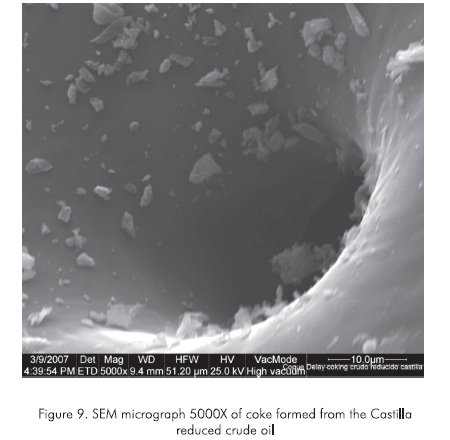
Figure 10 shows the micrograph obtained at 600X magnification for the coke sample from the Castilla reduced crude oil. This reduced crude oil has been previously treated with solvent at the deasphalting unit. Similar morphological characteristics to the associated shot type coke where amorphous structures predominate. An internal bubble tries to reach the surface in the upper part (position I) of Figure 10, forming a completely smooth and resistant macropore once the volatile material is associated. Besides, the pore surface is completely smooth and very similar to the external surface of the analyzed coke.
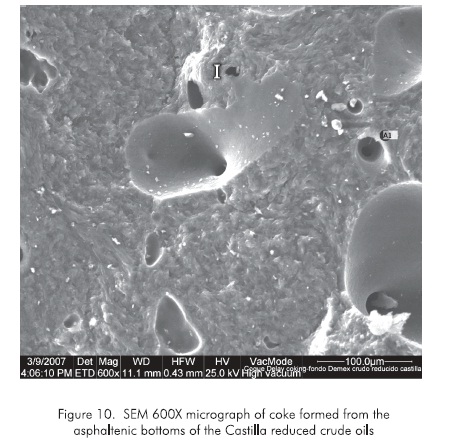
Figure 11 shows the micrograph obtained at 2000X magnification of the coke formed from the asphaltenic bottoms of the Castilla reduced crude oil. Rough granular mosaic size (position II) and medium rough appearance (position III) are observed.
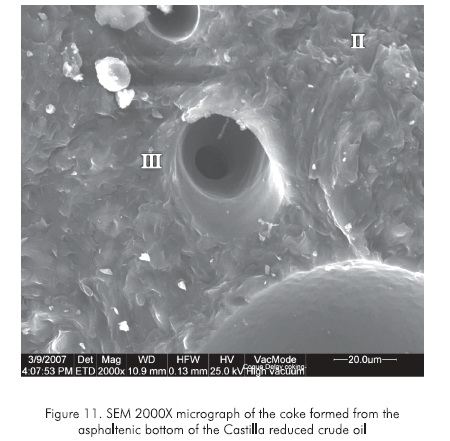
Figure 12 shows the micrograph obtained at 5000X magnification of the coke formed from asphaltenic bottoms of the Castilla reduced crude oil. The pore depth and the fine granular structure close to the pore wall are observed.
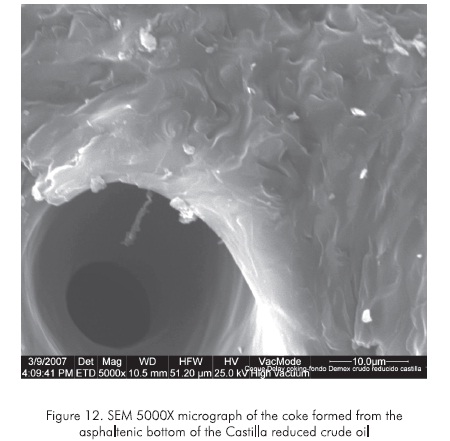
In general terms, the SEM micrographs completed for the classification cokes obtained Castilla reduced crude oil provided a description of the spheroid structures (shot-type) formed as a plastic fluid where volatile materials were evacuated creating completely smooth and resistant micropores that do not collapse once the gas material is eliminated from the coke solid matrix.
Associated shot type Coke
Shot-type associations are characterized by the presentation of a morphology with spheroid formations, smelted in clusters with a smooth and continuous surface on the surface where the spheroid particles attach. The presence of high nickel, vanadium and asphaltene content promotes the formation of this type of morphologies. (Siskin et al., 2006).
Figure 13 shows a micrograph at 100X magnification of the coke obtained from asphaltenic bottoms of the vacuum bottom of the Castilla crude oil which, initially, was submitted to the deasphalting process with solvent, ending its treatment at the coking pilot unit. The coke formed showed similar characteristics to the shot-type coke although with a trend toward the formation of a shot-associated morphology. The position IV shows the fractured internal surface of the material formed.
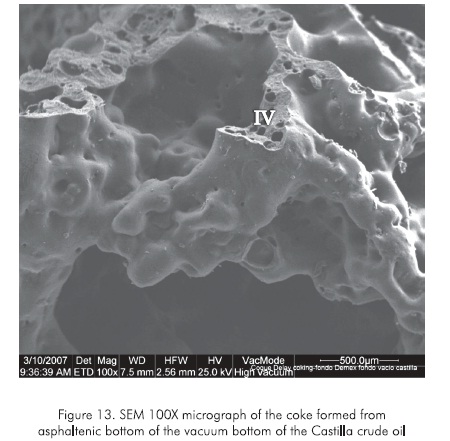
The chemical composition of the coked asphaltenic bottom was characterized by the presentation of tetra aromatic / tri aromatic ratios % wt greater than 1,1% and di-aromatic / tri-aromatic ratio less than 0,85% (Figures 4 and 6, respectively). High poly-aromatic composition in the tetra-aromatic / tri-aromatic ratio, meaning that this asphaltenic bottom is a potential forming agent of shot-associated morphologies.
JAZMÍN CRUDE OIL
Associated shot coke type
Figure 14 shows the micrograph obtained at 100X magnification of the coke formed from the Jazmín reduced crude oil. Clustered spheroid shapes are observed, thus classifying it in the morphological category of a shot-associated type coke. Regarding its chemical composition, the elevated di-aromatic / tri-aromatic concentration ratio (0,95% wt) and the moderate tetraaromatic / tri-aromatic concentration ratio (0,86% wt) (see figures 6 and 4, respectively). However, the increase of 90% in Calcium content (referred to the asphaltenic bottom content of the Castilla crude oil) as well as the increment of 35% in sulfur content (referred to the vacuum bottom of the Jazmín crude oil) generated the associated-shot morphological formation in the analyzed coke sample. The vanadium and nickel content in the Jazmín reduced crude oil was 80% less than the values reported for the asphaltenic bottom feedstock of the Castilla crude oil (Table 2), with similar morphology presented in the SEM micrograph (Figure 13).
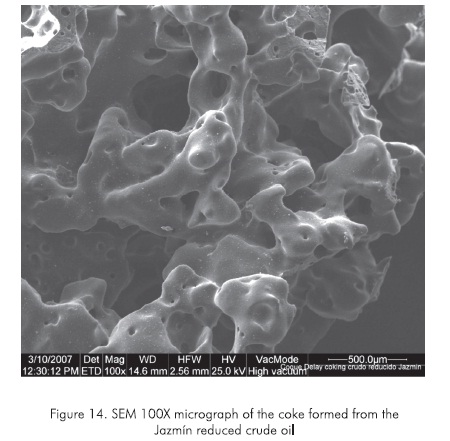
Recent research conducted by Kelemen et al., (2007) found that the content of nickel and vanadium are significant factors to take into account in formation and change of morphologies shot-associated type. However, the high content of sulfur and calcium heteroatoms in the coked feedstocks (reduced crude oil Jazmín) promoted the formation of morphologies shot-associated type. Conclusion, which aimed to include the contents of calcium and sulfur in union with the content of nickel and vanadium in the formation of morphologies shotassociated type.
Sponge-type coke
The chemical composition of the vacuum bottom obtained from the Jazmín crude oil showed % wt tetraaromatic / tri-aromatic ratios less than 1,1% wt and di-aromatic / tri-aromatic concentration ratios greater 0,85% wt. Besides, the metallic content concentration of nickel and vanadium was moderate. This classifies the vacuum bottom of the Jazmín crude oil as a potential former of spongy-type morphologies.
The sponge- type coke is classified as an intermediate coke between the shot type coke and the associated shot coke. The sponge type coke is characterized by its pore microstructure and the large diversity of pore size. This characteristic is possibly due to the release of volatile compounds during the coking reaction.
A liquid crystal growth of high viscosity occurs during the mesophase, and therefore, with limited fluidity. The fracture and stability degree depends, to high extent, on the amount of aliphatic compounds present in coked feedstocks, as it was observed in the sample of coke formed from the vacuum bottom of the Jazmín crude oil, with content of saturated products of 15% wt. The high aliphatic composition produced a large amount of volatile material which flowed through the mesogenic regions causing fractures to them.
Figure 15 shows the micrograph obtained at 100X magnification of the coke formed from the vacuum bottom of the Jazmín crude oil, at a scale of 500 µm, thus observing and confirming the presence of an elevated amount of pores with size and shape diversity. The sample of coke formed showed a sponge-like appearance with a multiplicity of pores and bubbles trapped in a solid coke matrix.
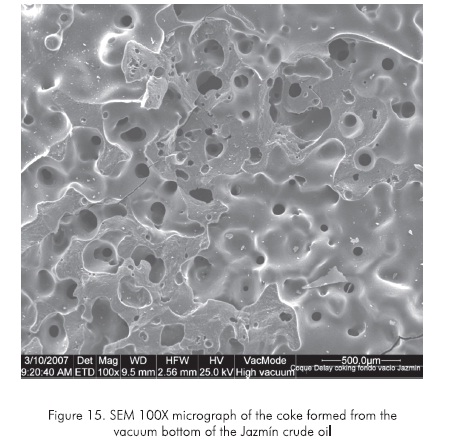
Figure 16 shows the micrograph obtained at 600X magnification of the coke formed from the vacuum bottom of the Jazmín crude oil at a 100 µm scale. The morphology between the walls of each pore is observed in the position V of the micrograph. Furthermore, the inner pore walls and their surfaces are observed. These structures as very smooth. The relative high concentration of aliphatic compounds (15% wt) which produced a volatile material that forced its lifting through the plastic matrix caused deformation and fractures in the coke obtained.
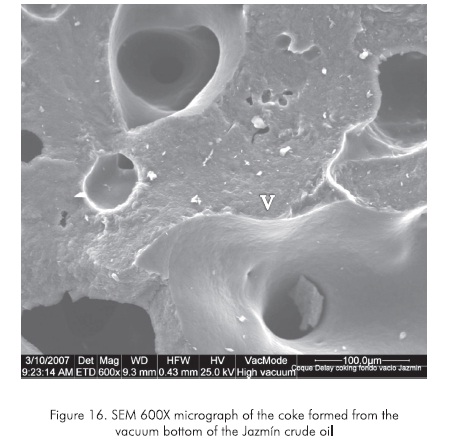
Figure 17 shows the micrograph obtained at 2000X magnification of the coke formed from the vacuum bottom of the Jazmín crude oil. An enlargement in the intermediate zone is observed, between the pore walls at a scale of 20 µm, as well as a medium granular texture. (position VI). A fine granular texture is observed in the position VII, elongated flow, characteristic of the pore walls.
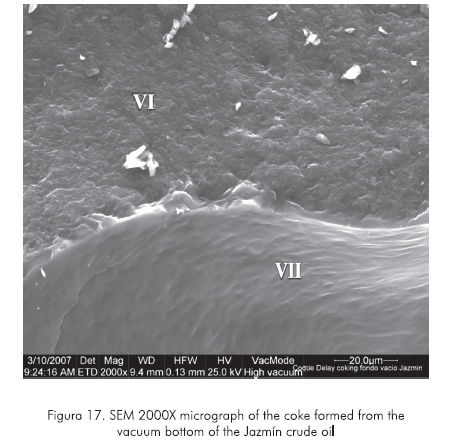
CONCLUSIONS
The cokes formed from the Castilla reduced crude oil and the asphaltenic bottoms of the Castilla crude oil produced shot-type and shot-associated cokes, characterized by its spheroid appearance with smooth external surfaces. In terms of chemical compositions, fractions with high boiling points obtained from the Castilla crude oil presented high asphaltene and metal content (nickel and vanadium), with polyaromatic concentration ratios in percentage weight tetra-aromatic / tri-aromatic greater than 1,1% wt and di-aromatic / tri-aromatic ratios less than 0,85% wt.
The coke obtained from the Jazmín reduced crude oil showed an associate shot-type morphology. This contrasts to the vacuum bottom of the Jazmín crude oil that originated a sponge-like morphological formation, the high calcium concentration present in the Jazmín crude oil fractions influenced the morphology of the cokes formed.
The concentration ratios according to the poly aromatic hydrocarbon type in the coked fractions, tetra-aromatic / tri-aromatic greater than 1,1% wt together with the di aromatic / tri-aromatic ratio less than 0,85% wt classified the coked feedstocks as generators of shot-type and associated shot-type morphologies in the cokes obtained. An opposite case is observed in the poly-aromatic ratio in the % weight of tetra-aromatic / tri-aromatic less than 1,1% wt together with the di-aromatic / tri-aromatic concentration ratio greater than 0,85% wt led to classify coked feedstocks as producers of sponge-type morphologies. Therefore, the chemical composition of coked feedstocks according to the type of polyaromatic hydrocarbon linked to the quantification of heteroatoms, such as nickel, vanadium, and calcium (as recently reported), offers a prediction mechanism regarding coke morphology based on feedstock quality. This conclusion that expands the metallic interval that is generally restricted to the nickelvanadium couple, commonly used in the orientation and prediction of morphologies in the cokes formed during coking reactions.
ACKNOWLEDGMENTS
Our special gratitude to ph.D. Martha Parra-Ramírez for her comments and contribution to the completion of this research. The cooperation from Universidad Industrial de Santander (UIS) and the Instituto Colombiano del Petroleo (ICP) - Ecopetrol.S.A. is also acknowledged for their support provided as a result of the technological cooperation agreement in progress.
REFERENCES
Ali, V. A. (2002). The Impact of Phase Behaviour on Coke Formation in Delayed Cokers. Thesis Master. Ing. Química. Toronto University, Canada, 220. [ Links ]
Badger, M., Mitchel, G. D., & Karacan, C. O. (2001). Characterization of heavy hydrocarbon cut by mass spectrometry routine and quantitative measurements. Fuel Science and Technol. Intl., 8 (9), 961-986. [ Links ]
Baldrich, C., & Novoa, L. (2007). Detailed Chemical Characterization of petroleum middle fractions by chemometrics analysis of their ultraviolet spectrum. CT&F - Ciencia, Tecnología y Futuro, 3 (3), 173-190. [ Links ]
Bouquet, M., & Brument, J. (1990). Characterization of heavy hydrocarbon cut by mass spectrometry routine and quantitative measurements. Fuel Science and Technol. Intl., 8 (9), 961-986. [ Links ]
Elliot, J. (2000). Shot Coke: Design & Operations. http://www.fosterwheeler.com/publications/tech_papers/ oil_gas/shotcoke.pdf [ Links ]
Gray, M. R. (2003).Tutorial on Upgrading of Oil sands Bitumen. http://www.ualberta.ca/~gray/~Library/Tutorials/ Upgrading [ Links ]
Gray, R. J., & Marsh, H. (1989). Introduction to carbon science. New York: Butterworth. [ Links ]
Karacan, C.O., & Badger, M. (2003). Effect of steam injection on pore structure and distribution in coke samples produced by delayed coking. Energy & Fuel, 82: 909-917. [ Links ]
Kelemen, S. R., Siskin, M., Gorbaty, M. L., Ferrughelli, D. T., Kwiatek, P. J., Brown, L. D., Eppig, C. P., & Kennedy, R. J. (2007). Delayed coker coke morpholo-gy fundamentals: mechanistic implications based on XPS analysis of the composition of vanadium- and nickel-containing additives during coke formation. Energy & Fuels, 21: 927-940. [ Links ]
Keller, A., Kovacs, R., & Homann, K. H. (2000). Large molecules, ions, radicals and small soot particles in fuel-rich hydrocarbon flames. Part IV. Large polycyclic aromatic hydrocarbons and their radicals in a fuel-rich benzeneoxygen flame. Chem. Chem. Phys., 2: 1667-1675. [ Links ]
Loison, R., & Marsh, A. (1989). COKE, Quality and Production. New York: Butterworth. [ Links ]
Murray, R. G., Elliott, J. W, & McCaffrey, W. C. (2005). Asphaltene fluid properties at process conditions. J. Petroleum. Institute, 48 (4), 181-188. [ Links ]
Picón, H. J., & Mahecha, C.A. (2001). Manual de Operación Planta Piloto de Coquización, Viscorreducción y Pirólisis. División de Procesos no Catalíticos. Manual de Operación, Instituto Colombiano del Petróleo (ICP) - Ecopetrol S.A. [ Links ]
Siskin, M., Kelemen, S. R., Eppig, C. P., Brown, L. D., & Afeworki, M. (2006). Asphaltene Molecular Structure and Chemical Influences on the Morpho-logy of Coke Produced in Delayed Coking. Energy and Fuels, 20:1227- 1234. [ Links ]
Siskin, M., Kelemen, S. R., Gorbaty, M. L., Ferrughelli, D. T., Brown, L. D., Eppig, C. P., & Kennedy, R. J. (2006). Chemical Approach to Control Morphology of Coke Produced in Delayed Coking. Energy and Fuels, 20: 2117-2124. [ Links ]
Sullivan, R. F., Boduszynski, M. M., & Fetzer, J. C. (1989) Molecular Transformations in Hydrotreating and Hydrocracking. Energy and Fuels, 3: 603 -612. [ Links ]
Wang, G. (2005). Molecular Composition of Needle Coke Feedstocks and Mesophase Development During Carbonization. Ph. D. Thesis, The Pennsylvania State University, University Park, PA, 299. [ Links ]
Wentzell, P., Andrews, D., Wall, J., Cooley, J., & Spencer, P. (1999). Estimation of hydrocarbon types in light gas oils and diesel fuels by ultraviolet absorption spectroscopy and multivariate calibration. Canadian Journal of Chemistry, 77 (3), 391-398. [ Links ]
Zander, M., & Collin, G. (1993). A review of the significance of polycyclic aromatic chemistry for pitch science. Fuel, 72 (9), 1281-1285. [ Links ]














